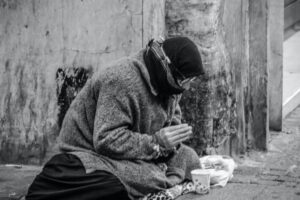
The monastic ideal of “leaving home” is repeatedly praised by Master Dogen in the ordination ceremony known, in Japanese, as “Shukke Tokudo” — which translates as something like “leaving home, sharing the dharma.” In lay practice, we do not literally leave home, of course, other than for the occasional extended retreat, or sesshin; but we interpret the meaning as deeply significant. Our true home turns out to be unrelated to geography, or any other relative circumstances of existence.
We might also question the reality of home-leaving in the life of monastics, as Master Dogen mentions regarding monks of his time (see Shobogenzo Zuimonki). He suggests that some cannot really relinquish their attachment to family, and all that it entails, for the sake of Zen — or “hearing the true Dharma” as he puts it in Dogen’s Vow (Eiheikosohotsuganmon).
Others, who are able to do so, are not able to let go of their attachment to their body and good health. They are not willing to put their life on the line, which is, after all, understandable — in this same poem he quotes Ch’an Master Lungya: “In this life save the body; it is the fruit of many lives” — but I take his point to be that the obsession with living the good life, at the expense of Zen practice, is ultimately doomed to failure. Aging, sickness and death, the three major marks of existence, according to Buddhism, cannot be avoided in the long run. And Zen takes the long view.
But the third and most difficult level of non-attachment that Dogen Zenji stresses, is to our own ideas and opinions. Even monks who can realize the first two levels have difficulty with this last, clinging to their erroneous worldview. The monk who can do so has the best chance of waking up during this lifetime.
Lay Practice — Highest Level of Zen
This brings up an interesting point, a seeming contradiction, that Dogen does not go into. Achieving this last bit of letting go — of the “ties that bind” — implies letting go of our viewpoints. Including, most notably, regarding the prior two levels — relinquishing normal lay life of family and friends, status, and so on; as well as our attachment to our own life and health.
In other words, if we truly let go of all of our own opinions, this would necessarily include any preconceptions, such as that the most advanced monk or nun is detached from family and body. Not necessarily. In Zen, we give up our opinions of all such kinds of attachment. It is, after all, natural to be attached to both; the distinction lies in the degree to which we are attached to them. This is the heart of the Middle Way.
A clear example of this is found in pain. We experience pain in meditation. But we do not immediately react, doing something to make it stop right now. We sink into it a bit more than we usually would, going beyond our comfort zone. In doing so, we have an opportunity to truly experience the “pain” for what it really is.
Thus, we may discover that it is not so bad; certainly not life-threatening, in any case. Although, even if we thought it were, according to Dogen, we should not shrink from it. The point is, unless we are able to set aside our preconception that pain = bad, we cannot learn from the experience. This principle then applies to all of our aversions in life. Aversion is simply the flip side of attachment.
Master Dogen’s assessment of the levels of commitment of various monks ends with the rare case of one who is able to surrender to, or to sunder, ties to family, health and life, and, finally to one’s own worldview — as the highest and truest form of liberation from the random circumstances of our present human birth. But since the last relinquishment is of personal opinion of “all the above,” it would lead to the conclusion that the life of the lay householder is not distinct from that of the monk or nun, in any way that counts. It is a case of the famous distinction without a difference. If the circumstances of lifestyle are only that — circumstance — then by definition they are not central, to living the Zen life.
Thus, we could propose that the lay person — who is able to relinquish all opinion, and “succeed to the wisdom of the buddhas” (see Fukanzazengi) — is the highest possible level of all. This may be why, in the history of Buddhism and Zen, such lay persons as Vimalakirti, Emperor Ashoka, Layman Pang, and others, are so admired. In spite of having their plates full, of domestic and even governmental duties, they were able to gain profound insight into the Dharma, without renouncing their ordinary life. Not to mention certain monks who were known to flout the norms of monastic life.
Of course, you cannot tell this book by its cover, so it is best to consider only our own practice, and not to judge others from outward appearances.
Contemporary Lay Practice
Contemporary lay practice is probably vastly different from that of the countries of origin, today, as well as in ancient times. My limited understanding suggests that most lay householders practiced dana — supporting the monks and nuns with offerings of food and material support, including currency and other forms of fungible goods. The community was engaged in other, interactive ways as well. Young children would be sent to the temples and monasteries for training, which probably amounted to a kind of finishing school, with some study of Buddhism. The early monasteries of the East probably evolved into the institutions of higher learning, as they did in the West, in Europe, for example. But the actual practice of Zen meditation, specifically, was probably not widespread.
Today, however — and I think perhaps especially in North and South America, as well as in Western Europe — lay practitioners generally equate Zen practice with meditation. Particularly in the USA, we tend to be do-it-yourselfers. We are not satisfied with second-hand information, and look to direct experience as having its own value, in most everything we do.
Thus, Zen training is closely related to an apprentice mode, as in a craft or guild, wherein a novice becomes an apprentice to a master; eventually a journeyman; and is finally certified as a master. But we must be careful about this idea of becoming a “Zen Master.” We do not master Zen — Zen master us. But only if we allow it.
As Master Dogen reminds us in the Genjokoan excerpt from his first written fascicle for his masterwork, Shobogenzo, titled Bendowa, “When buddhas are truly buddhas they do not necessarily notice that they are buddhas.”
If waking up is simply waking up to reality, in Zen, it would not necessarily include taking on a new self-identity as a buddha. It might, however, include seeing oneself, as well as others, in a somewhat different light. “Your body and mind, as well as the body and mind of others, drop away” as Dogen assures us in the same teaching.
Living the Zen Life Today
While we may admire, and hope to emulate, the life of a monk or nun, I believe we do not have enough grounding in the reality of that choice — nor in the cultures of the countries of origin in which it originally arose. The choices we have today, in terms of maintaining Zen practice in the midst of life, are surely very different from those of ancient India, for example. Joining the Order meant leaving behind the conventional trappings of society, including family (though some of Buddha’s followers seem to have been his blood relatives), position, wealth, and so on.
The original Order first included men only, but during Buddha’s lifetime, expanded to include women. From what I have gathered, any adult from any level of the caste system of the time could join, as long as they were willing to forego the privilege and provenance of their upbringing. This, it seems to me, had to do with renouncing the self, in the conventional sense.
This tradition is what Master Dogen, some 1300 years later, referred to as “leaving home” in laudatory measures. Today, we join the community, or Sangha — and can even become ordained as a priest — without literally leaving home in the obvious, outer sense of the phrase. However, when we undergo Shukke Tokudo, ordination as a novice priest, the implication is that we leave our ostensible home, in order to find our true home, in homelessness.
Our True Home — Homelessness
This homelessness is considered the original, or natural, way of being, and has nothing to do with where we were born, or where we dwell in the geographic sense. The latter, the circumstances of our birth, as well as our livelihood and eventual death, are just that — circumstantial. They are not central to our being, though they may play an inordinate role in shaping our worldview, and, indeed, whether or not we are even exposed to the Dharma.
This human birth is considered rare in Buddhism, though with seven billion and counting, it may appear to be so common as to threaten the survival of the species. By comparison to other life forms, such as insects, we are not even close to predominance, as measured in biomass. But the disproportionate effect that we as human beings have on the environment amounts to a crisis. We may want to broaden our scope to embrace the possibility of extinction of the race, along with our own, personal mortality. There is no greater form of homelessness than to become extinct.
ASZC & STO as Collaborative Community
Each month, during our Second Sunday Sangha lunch and dialog at ASZC, we discuss issues of how we as individuals can join in the efforts of promoting true community, without compromising our own personal lives as householders and lay Zen people. Matsuoka Roshi predicted, and I concur, that the rebirth of Zen would be seen in America, and its form would be primarily lay practice. He also would often remark that “Zen is always contemporary.” That is, we don’t have to try too hard to make it contemporary.
We have just passed the first-year anniversary of what might be considered one of the all-time great failures of community, that seen in Charlottesville, Virginia. It recalled to mind the greatest international example from history, that which led to WWII. But it is only the latest in an ongoing series of catastrophes, both natural and human, that have plagued the human community since the beginning of recorded history. Any student of history is not surprised by the daily catastrophes that we witness on the news. This is human nature in full flower. It is why we aspire to buddha nature instead.
Now we are in the adolescent throes of establishing Zen community in America. The confusion inflicting this process is to be expected, owing to both the quirks of contemporary Western society, and the persistence of myths surrounding the origins of Zen practice in the seminal communities in India, China, Korea, Japan, and the far East. Most of the confusion arises, I think, from the supposed contrasts and apparent contradictions between traditional monastic, and contemporary lay, lifestyles.
So as if we need one more thing to worry about, we do not want to become attached to the propagation of Zen as another preconceived project in its own right. We are privileged to be exposed to the Dharma, in the humblest sense of the term, and not merely by dint of circumstances of our birth, the source of social privilege. Let us not miss this opportunity to join with the Zen community, and to serve its members in true collaboration. It is in our enlightened self-interest to do so.







